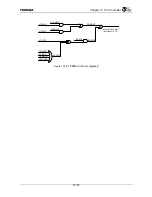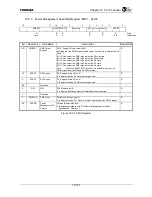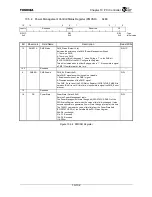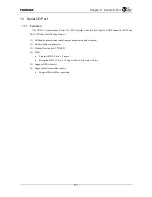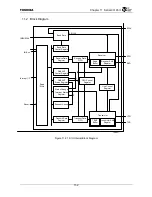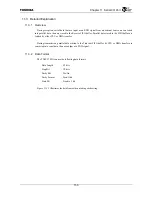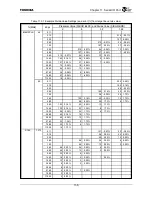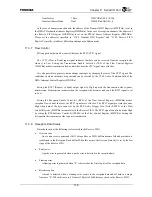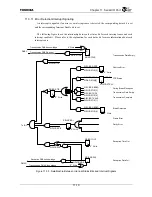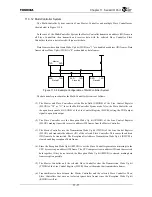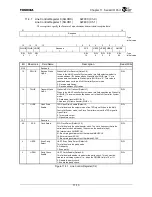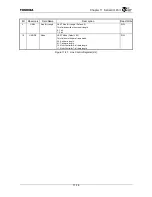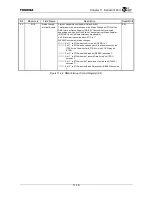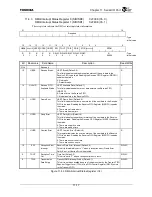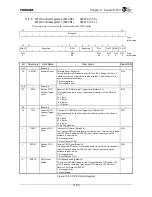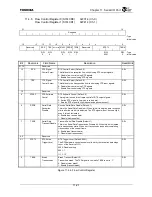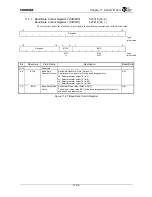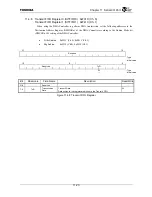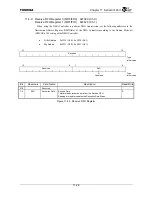
Chapter 11 Serial I/O Port
11-9
The Reception Error Interrupt bit (SIDISR.ERI) of the DMA/Interrupt Status Register (SIDISRn) is
set when one of the following errors is detected: an overrun error, a parity error, or a framing error. An
interrupt is signaled if the Reception Error Interrupt Enable bit of the DMA/Interrupt Control Register
(SIDICRn) is set.
The Break Detected bit (UBRKD) and the Receiving Break bit (RBRKD) of the Status Change
Interrupt Status Register (SISCISR) is set when a break is detected. The Break Detected bit (UBRKD)
remains set until it is cleared by the software. The Receiving Break bit (RBRKD) is automatically
cleared when a frame is received that is not a break.
The status of the next reception data to be read is set to the Overrun Error bit (UOER), Parity Error
bit (UPER), Framing Error bit (UFER), and the Receive Break bit (RBRKD). Each of these statuses is
updated when reception data is read from the Receive FIFO Register (SIRFIFOn).
During DMA transfer, an error is signaled and DMA transfer stops with error data remaining in the
Receive FIFO if either an error (Framing Error, Parity Error, or Overrun Error) or a Reception time out
(TOUT) is detected. If a Reception Error occurs during DMA transfer, use the Receive FIFO Reset bit
(RFRST) of the FIFO Control Register (SIFCRn) to clear the Receive FIFO. However, a software reset
will be required if a reception overrun error has occurred. Refer to “11.3.10 Software Reset” for more
information.
11.3.9 Reception
Time
Out
A Reception time out is detected and the Reception Time Out bit (TOUT) of the DMA/Interrupt
Status Register (SIDISR) is set under the following conditions.
•
Non-DMA transfer mode (SIDICRn.RDE = 0):
When at least 1 Byte of reception data exists in the Receive FIFO and the data reception time for
the 2 frames (2 Bytes) after the last reception has elapsed
•
DMA transfer mode (SIDICRn.RDE = 1):
When the data reception time for the 2 frames (2 Bytes) after the last reception has elapsed
regardless of whether reception data exists in the Receive FIFO
11.3.10 Software Reset
It is necessary to reset the FIFO and perform a software reset in the following situations.
1. After transmission data is set in FIFO, etc., transmission started but stopped before its completion
2. An overrun occurred during data reception
Software reset is performed by setting the Software Reset bit (SWRST) of the FIFO Control Register
(SIFCR). This bit automatically returns to “0” after initialization is complete. This bit must be set again
since all SIO registers are initialized by software resets.
Summary of Contents for TX49 TMPR4937
Page 1: ...64 Bit TX System RISC TX49 Family TMPR4937 Rev 2 0 ...
Page 4: ......
Page 13: ...Table of Contents ix TMPR4937 Revision History 1 ...
Page 14: ...Table of Contents x ...
Page 15: ...Handling Precautions ...
Page 16: ......
Page 18: ...1 Using Toshiba Semiconductors Safely 1 2 ...
Page 40: ...3 General Safety Precautions and Usage Considerations 3 18 ...
Page 42: ...4 Precautions and Usage Considerations 4 2 ...
Page 43: ...TMPR4937 2005 3 Rev 2 0 ...
Page 44: ......
Page 52: ...Chapter 1 Overview and Features 1 6 ...
Page 156: ...Chapter 7 External Bus Controller 7 56 ...
Page 491: ...Chapter 16 Removed 16 1 16 Removed ...
Page 492: ...Chapter 16 Removed 16 2 ...
Page 493: ...Chapter 17 Removed 17 1 17 Removed ...
Page 494: ...Chapter 17 Removed 17 2 ...
Page 495: ...Chapter 18 Removed 18 1 18 Removed ...
Page 496: ...Chapter 18 Removed 18 2 ...
Page 497: ...Chapter 19 Removed 19 1 19 Removed ...
Page 498: ...Chapter 19 Removed 19 2 ...
Page 506: ...Chapter 20 Extended EJTAG Interface 20 8 ...
Page 530: ...Chapter 22 Pinout and Package Information 22 10 ...
Page 542: ...Chapter 24 Parts Number when Ordering 24 2 ...

